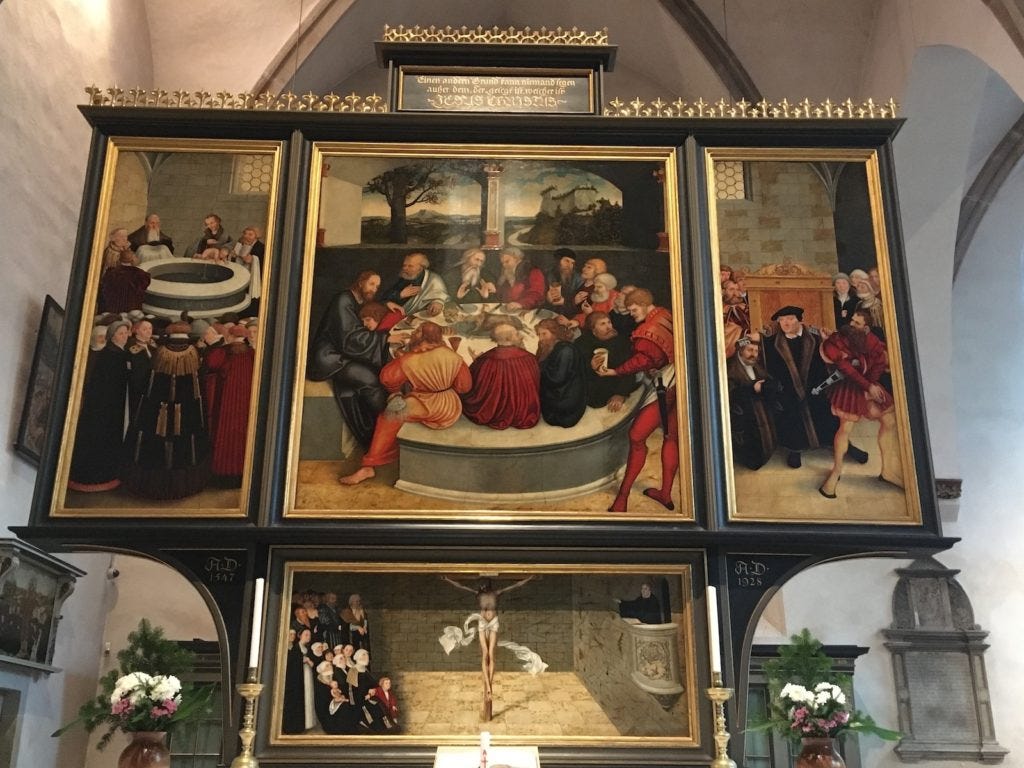Augsburg Confession, Article VIII: “What The Church Is”
1 Strictly speaking, the Church is the congregation of saints and true believers. However, because many hypocrites and evil persons are mingled within them in this life, it is lawful to use Sacraments administered by evil men, according to the saying of Christ, “The scribes and the Pharisees sit on Moses’ seat” (Matthew 23:2). 2 Both the Sacraments and Word are effective because of Christ’s institution and command, even if they are administered by evil men.
3 Our churches condemn the Donatists, and others like them, who deny that it is lawful to use the ministry of evil men in the Church, and who think that the ministry of evil men is not useful and is ineffective.
[From Concordia: The Lutheran Confessions. 2005 (P. T. McCain, Ed., CPH)]
The Church is where God’s Word and Sacraments are, as Matthew 28:19 teaches, and as the Augsburg Confession [Article VII and VIII] explains. The Apology of the Augsburg Confession goes on to call the pure teaching of the gospel and the sacraments the “marks” of the Church. (Apology VII, 20) These marks identify where the Church is gathered and located. This Church is visible in so far as one sees these marks – this is called the local Christian congregation.
Who belongs to this Church are all who believe and are baptized, as our Lord teaches us at Mark 16:16. This is “the congregation of saints and true believers” as Article VIII confesses. This is the “invisible” Church – as only God can see what is truly in the hearts and minds of every person. Yet, where the Gospel is taught purely, and the Sacraments administered rightly, the public marks of the Church, we can be sure that there is where fellow believers in Christ are indeed located – they will be gathered around our Lord, in His living Word (Luke 24:47), in His Baptismal waters (Matthew 28:19), in His Absolution (John 20:21-23), and in His Holy Supper (Matthew 26:26).

So we have one and the same Church but in different respects. Invisible in respect to “who” are members, but visible in respect to “where” it can be found, and all based on the clear Words and Promises of Christ.
Sadly, despite the clarity of the Scriptures, and despite the work of the Holy Spirit to call, gather, enlighten, and sanctify the whole Christian Church on earth and keep it with Jesus Christ in the one, true faith, even the Church suffers in this corrupted, sin-sickened world. Hypocrites and evil persons are mingled within the true believers in this life. See Jesus’ parable of the weeds and the wheat, Matthew 13:24-30. The devil attacks saving faith in Christ, seeks to take it away through temptations and unbelief, tribulation and persecution and the cares of this life drive and choke off the faith that Christ plants in hearts, Mark 4:1-20.
Some Christians reject the means of grace and look for their own inner experiences and outward confessions as the basis of their faith. Some reject the necessity of faith in Christ altogether and choose to depend upon their own works and righteousness. Some reject Christ altogether and yet outwardly attempt to appear pious.
Despite these sad realities, “though with a scornful wonder the world sees her oppressed, by schisms rent asunder, by heresies distressed,” (LSB #644, stanza 3, public domain) the Means of Grace, the Word and Sacraments, are efficacious, they do what God says they will do. Their validity, and what the Church is, does not depend upon any person, even if the pastor himself is found to be wicked and a hypocrite, even if some who receive the Means of Grace turn out to be evil hypocrites. The Church, and her public marks, are what they are because God’s Word of command and promise are behind them, and the Holy Spirit promises to work through those means, gathering and calling unto the Father, through the Son, a holy people.



